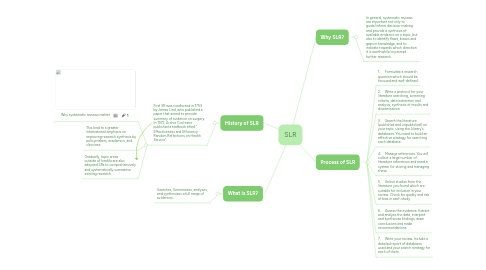SLR
作者:RENUGA KRISHNARAJ

1. History of SLR
1.1. First SR was conducted in 1753 by James Lind, who published a paper that aimed to provide summary of evidence on surgery. In 1972, Archie Cochrane published a textbook titled " Effectiveness and Efficiency: Random Reflections on Health Service".
1.1.1. Why systematic reviews matter
1.1.2. This lead to a greater international emphasis on improving research synthesis by policymakers, academics, and clinicians.
1.1.3. Gradually, topic areas outside of healthcare also adopted SRs to comprehensively and systematically summarise existing research.
2. What is SLR?
2.1. Searches, Summarizes, analyses, and synthesizes a full range of evidences.
3. Why SLR?
3.1. In general, systematic reviews are important not only to guide/inform decision-making and provide a synthesis of available evidence on a topic, but also to identify flaws, biases and gaps in knowledge, and to indicate towards which direction it is worthwhile to prompt further research.
4. Process of SLR
4.1. 1. Formulate a research question which should be focused and well-defined.
4.2. 2. Write a protocol for your literature searching, screening criteria, data extraction and analysis, synthesis of results and dissemination.
4.3. 3. Search the literature (published and unpublished) on your topic, using the Library's databases. You need to build an effective strategy for searching each database.
4.4. 4. Manage references. You will collect a large number of literature references and need a system for storing and managing these.
4.5. 5. Select studies from the literature you found which are suitable for inclusion in your review. Check for quality and risk of bias in each study.
4.6. 6. Assess the evidence. Extract and analyse the data, interpret and synthesise findings, draw conclusions and make recommendations.
4.7. 7. Write your review. Include a detailed report of databases used and your search strategy for each of them.


